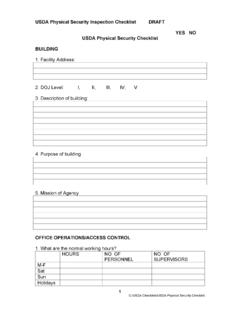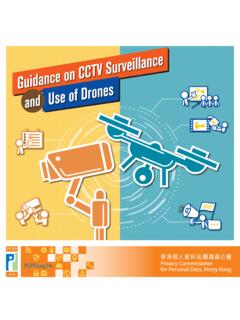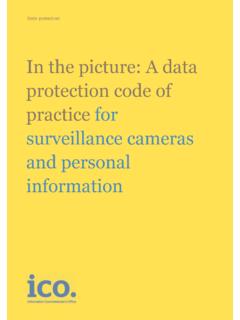Transcription of NPC Advisory No. 2020-04 - National Privacy Commission
1 Republic of the Philippines National Privacy Commission 5/F Delegation Building, PICC Complex, Vicente Sotto St., Pasay City URL: Email Add: NPC Advisory No. 2020-04 DATE : 16 NOVEMBER 2020 SUBJECT : GUIDELINES ON THE USE OF closed -CIRCUIT TELEVISION ( cctv ) SYSTEMS SECTION 1. General Principles. This Advisory is governed by the following principles: A. cctv systems, where used reasonably and appropriately, are tools which support safety and security of personal information controllers (PICs), personal information processors (PIPs), and data subjects. B. The use of cctv systems shall consider its impact on the rights and freedoms of data subjects and be subject to regular review to ensure that its use remains to be necessary for specified and legitimate purposes.
2 C. The capture, use, retention, and destruction of video and/or audio footages obtained from CCTVs are considered as processing of personal data under the Data Privacy Act of 2012 (DPA). Those who process personal data through cctv systems, whether as PICs or PIPs shall comply with the Data Privacy Act of 2012, its Implementing Rules and Regulations (IRR) and relevant issuances of the National Privacy Commission (NPC). SECTION 2. Scope. This Advisory shall apply to all PICs and PIPs engaged in the processing of personal data through the use of cctv systems operating in public and semi-public areas. These include cctv systems that record videos, as well as those systems with both video and audio capabilities. SECTION 3. Definition of Terms. Whenever used in this Advisory , the following terms shall have their respective meanings as hereinafter set forth: A.
3 Act or DPA refers to Republic Act No. 10173, otherwise known as the Data Privacy Act of 2012; B. Commission or NPC refers to the National Privacy Commission ; C. closed -Circuit Television or cctv refers to closed -circuit television or camera surveillance system in a fixed or stationary location that can capture images of individuals or other information relating to individuals; D. Data Subject refers to an individual whose personal, sensitive personal, or privileged information is processed; 2 E. Masking refers to concealing parts of the video or still imagery from view, which may include masking certain body parts or inanimate objects that could potentially disclose the identity of an individual. The common types of masking include solid color masked areas, where no details or movement in the scene covered by the masked area can be viewed, and blurred masking or pixelated masking, where the resulting images enables a partial outline to be seen but with detailed features F.
4 Personal information refers to any information whether recorded in a material form or not, from which the identity of an individual is apparent or can be reasonably and directly ascertained by the entity holding the information, or when put together with other information would directly and certainly identify an individual; G. Personal information controller or PIC refers to a person or organization who controls the collection, holding, processing or use of personal information, including a person or organization who instructs another person or organization to collect, hold, process, use, transfer or disclose personal information on his or her behalf. The term excludes: 1. a person or organization who performs such functions as instructed by another person or organization; or 2.
5 An individual who collects, holds, processes or uses personal information in connection with the individual s personal, family or household affairs. There is control if the natural or juridical person or any other body decides on what information is collected, or the purpose or extent of its processing; H. Personal information processor or PIP refers to any natural or juridical person or any other body to whom a PIC may outsource or instruct the processing of personal data pertaining to a data subject. I. Processing refers to any operation or any set of operations performed upon personal data including, but not limited to, the collection, recording, organization, storage, updating or modification, retrieval, consultation, use, consolidation, blocking, erasure or destruction of data; J.
6 Public space refers to a space that is generally open and accessible to the public, such as highways, streets, footbridges, overpass/underpass, parks, plazas, sidewalks, and other similar spaces; K. Semi-public space refers to a space that, even if privately owned, is accessible to the public during operating hours. This include banks, educational institutions, hospitals, malls, offices, restaurants, transport stations, shops, and other similar SECTION 4. Guidelines. The processing of personal data in cctv systems shall be subject to the following guidelines: 1 See: Singapore Personal Data Protection Commission , Advisory Guidelines on the PDPA for Selected Topics (revised 28 March 2017). 2 See generally: Privacy Commissioner of New Zealand, Privacy and cctv : A Guide to the Privacy Act for Businesses, Agencies, and Organizations (2009).
7 3 A. Legitimate purpose. Prior to installing a cctv system, the purpose/s for personal data processing using such system must be clearly determined. Such processing may be permitted for the following purposes, except where the same are overridden by the fundamental rights and freedoms of the data subject: 1. Compliance with a law or regulation, where the same guarantees the protection of personal data; 2. Security of properties and protection of vitally important interests of individuals; 3. Ensure public order and safety; and 4. Other legitimate interests. PICs shall identify an appropriate lawful basis for processing under the DPA and provide such basis when required by the Commission . B. Proportionality. The PIC should evaluate whether the installation and operation of cctv systems and the nature and kind thereof is necessary for its legitimate purpose, considering whether such purposes could be reasonably fulfilled by other less intrusive means.
8 Collection and further processing of personal data from cctv systems should only be to the extent necessary to fulfill the legitimate purpose. C. Transparency. PICs and PIPs shall provide cctv notices which are readily visible and prominent within their premises, such as at points of entry, or other conspicuous areas. The cctv notices shall provide information to the public that there is a cctv system in operation in clear, plain, and concise language. D. cctv policy. PICs and PIPs are obliged to have a policy governing the operation of cctv systems. Such policy shall provide details on the following: 1. Designation of an authorized personnel who shall have access to and responsibility for the operation, control, and monitoring of the cctv system; 2. cctv notice/s and placement thereof; 3.
9 Procedure for requests for access to cctv footages and providing a recording or copy thereof when requested that is consistent with the principles of these Guidelines; 4. Retention period of cctv footages and manner of disposal/destruction thereof when period of retention has lapsed; 5. Security measures to be implemented for the protection of cctv footages against any unlawful interference or interception, unauthorized access by copying, recording or viewing, accidental or unlawful destruction, alteration, and disclosure, as well as against any other unlawful processing; 6. Conduct of regular evaluation and audit of security measures and whether the use of cctv remains to be justified; and 7. Process for the regular review and assessment of the policy and its revision, if necessary.
10 E. Location and placement. To ensure that cctv systems capture footages in a manner consistent with the DPA, the location and angles of the cameras must be carefully considered. CCTVs shall only be used to monitor the intended spaces, taking into consideration the purpose for monitoring the same. 4 The use of CCTVs in areas where individuals have a heightened expectation of Privacy ( fitting rooms, rest rooms, toilets, lactation or breastfeeding rooms, and other similar places) is prohibited. F. Quality and integrity of data. cctv systems shall record images that are of suitable quality to meet the purposes for which it was installed or intended. PICs shall implement reasonable and appropriate safeguards to ensure and maintain the integrity and accuracy of the footage recorded and stored, including any associated meta data ( time, date, and location), and to facilitate access requests for cctv footage.









